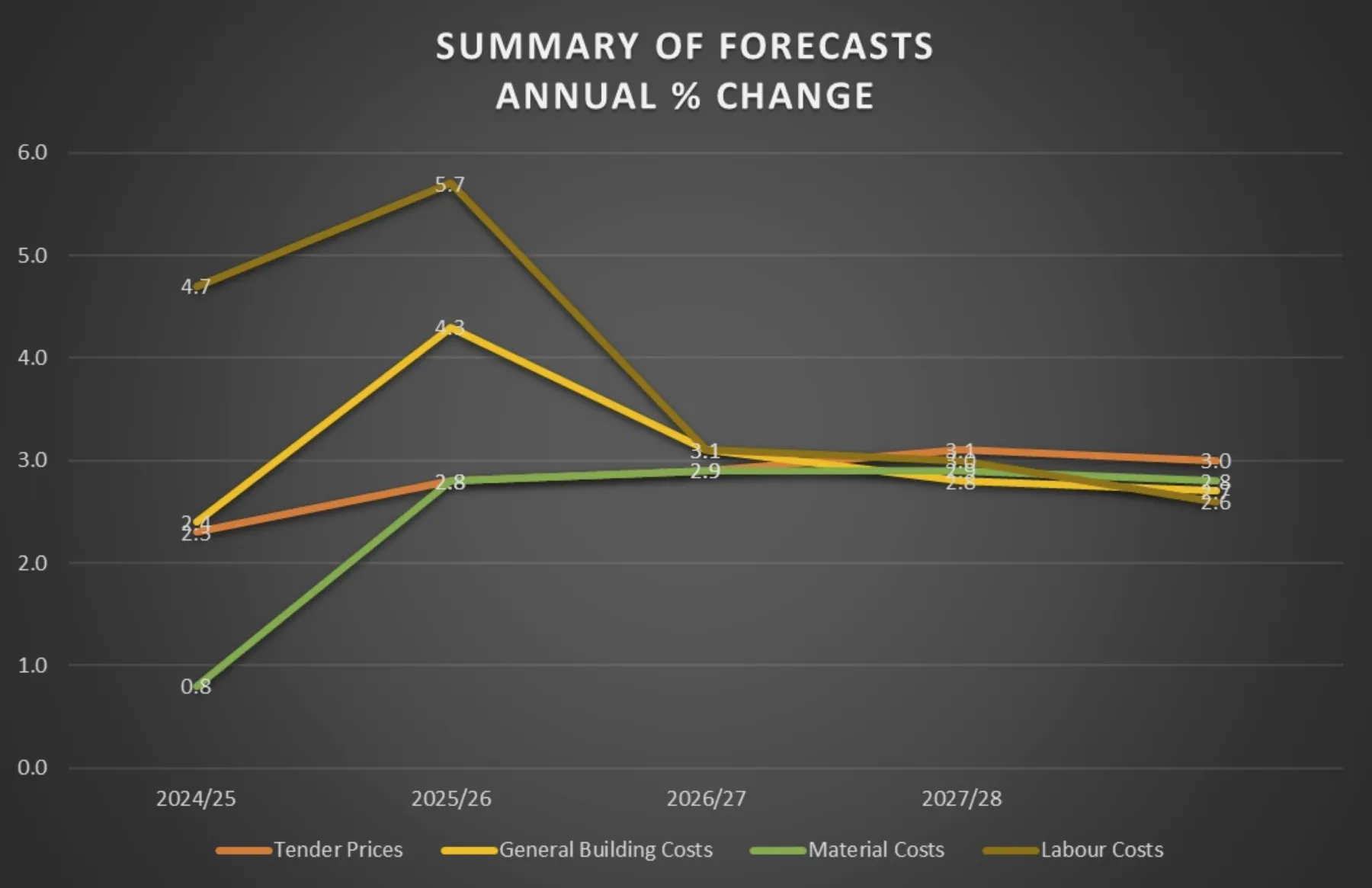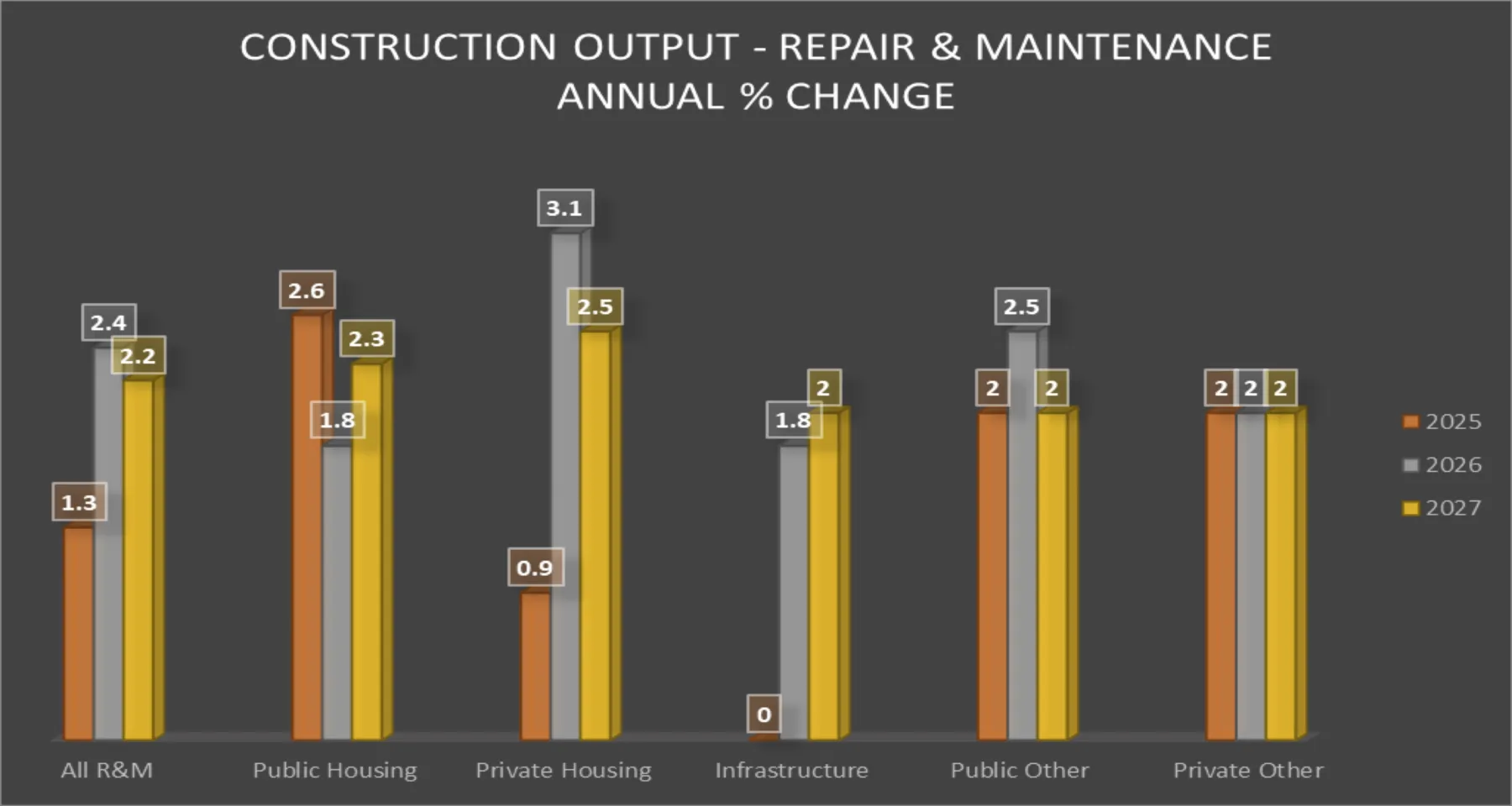Market Outlook April 2025
The outlook for the UK economy is still downbeat for the rest of this year, but with better overall growth in GDP now forecast from 2026 onwards.
The latest GDP forecast was reduced by half to only 1% for 2025, but with average increases of 1.8% from 2026 to 2029. Inflation forecasts are up from 2.6% to 3.2% average for 2025, before reducing to 2.1% in 2026.
The growth seen in the first half of 2024 year has continued to slow, with confidence waning in response to continuing economic uncertainty worldwide.
The Construction sector has also experienced declining positivity, as evidenced by the UK Construction Purchasing Managers' Index surveys (a general indicator of construction industry sentiment). After maintaining positive readings for the last nine months of 2024, the index fell below 50% in January and dropped a further 3.55 points in February—the sharpest monthly decline since May 2020 during the Covid-19 pandemic. This indicates a significant contraction in overall construction activity, with residential building and infrastructure among the worst affected sub-sectors of the industry.
The Government’s recent Spring Statement did include increased ‘Capital Spending’ of £2bn a year but that is likely to be focused on the defence sector in the short term, which along with the promised planning system amendments should speed up developments and drive economic growth in general through large construction projects, such as the recently announced new Thames Crossing.
The recent small decrease in inflation (CPI) to 2.8% in February which followed an increase to 3% in January is unlikely to lead to a further 0.25% reduction in Base Rate by the Bank of England in April as widespread national and international economic concerns remain, with the conflicts in Ukraine and the Middle East ongoing and the impact of trade tariffs by the US still to be fully resolved. It is likely that in the short term the bank will adopt a more cautious approach as inflation stays above the often stated 2% target, which is now expected to be reached in 2027.
Local Outlook
Looking at Scotland in general, the construction sector continues to suffer from lower demand, however, the view on anticipated pipelines of projects going to tender over the next 12 months has improved slightly over the last quarter with the majority of companies forecasting either an increase in opportunities or unchanged position rather than a reduction.
However, Contractors have raised concerns about the lack of information on forthcoming projects with public sector organisations not listing projects online and Consultants not having the long-term view of a few years ago.
Contractors' interest in tendering for projects remains generally positive, with increased availability and desire to secure work, though they are being selective about which projects they will price. Mechanical and Electrical works continue to present challenges in obtaining competitive prices due to labour constraints and a limited number of companies capable of undertaking larger or more complex projects, resulting in higher price increases compared to general building trades.
Labour resource availability and general skill shortages in Scotland have been highlighted as significant concerns. The expected increase in renewable energy projects in the Highlands and Islands is likely to impact general building projects in those areas unless the gaps are filled by workers from the south of the country. This migration of workers could, in turn, create new labour shortages in the central belt.
The Scottish BCIS panel noted that while the recent Scottish Government’s budget for 2025/26 had provided some positive news, with major healthcare projects resuming, it was generally downbeat with public sector finances remaining tight.
Both the BCIS Consultants and Contractors panels reported that with inflation having stabilised over the last year the sharing of risk is becoming more accepted with Contractors more likely to take on risk and price it into their tenders.
Summary of Forecast
The following forecasts are based on a middle of the road set of assumptions with regards to trade restrictions and economic performance by the UK economy as a whole. However, the figures could vary by up to 15% (+/-) per annum over the period of the forecast.

Overall, UK Tender prices rose by 0.5% over the last quarter, with a rise of 0.9% identified in Scotland. The annual rise increased by a further 0.2% to 2.3% (3.4% in Scotland) when compared with the same quarter in 2024. The overall view of the UK TPI panel was downbeat in comparison with the previous quarter, with the view that tender price increases have been slowing with the trend likely to continue until the end of 2025 before picking up in 2026.
There is still widespread evidence of a differential in the movement of tender prices between M&E and general building works, with a limited pool of skilled labour routinely cited as the main factor, resulting in a lack of competitiveness through a restricted marketplace, particularly evident on larger projects in Scotland at present.
The level of competitive pricing currently being experienced has declined slightly from the last quarter, with Contractors being more selective on what they will price. Over the next five years tender prices are currently forecast to rise by 14% overall, a 4% decrease compared to the last forecast, now at a lower rate than building costs, with concerns as to future opportunities beginning to become evident.
Building costs rose by 0.5% in the last quarter when compared to the previous quarter and by 5.3% from the same quarter a year ago, an increase of 2.9% from the 2.4% reported in the last forecast, driven by the 3% increase in heating and ventilation sector wage rates. Building costs are forecast to rise by 17% in total over the next 5 years, an increase of 2% from the previous forecast, with increases in labour costs being the main cause.
Construction Output
New work output declined by 5.3% in 2024 with growth of 2.8% forecast for 2025, followed by higher increases of 4% - 6% per annum over the next couple of years, driven predominantly by the housing sector as a result of the UK Governments aim to deliver 1.5 million new homes by 2029.

There was however a slightly better picture for the Repair and Maintenance sector, with an annual increase of 8.5% in 2024, but with growth rates expected to reduce over the period of the current forecast. Annual increases are expected to range from 0.0% - 3.1% as shown in the graph below.

Conclusion
The market views in construction have changed markedly since the beginning of the year and, with economic growth stagnating and inflation starting to pick up again it is widely considered that 2025 will be another difficult year for construction with only minimal output growth evident before growth accelerates from 2026 onwards.
Whilst the cost of borrowing is reducing there is no real evidence of increased levels of investment in built assets and increases in both input costs and tender prices due to the National Insurance uplift, will most likely result in more potential affordability issues over the next couple of years.
In the public sector, financial constraints will put increased spending at risk which will impact growth in infrastructure output unless alternative funding sources can be found, and in the private sector the subdued economic outlook is expected to lead to lower output growth in both the industrial and commercial sectors going forward.
Sign up for news
Receive email updates from Thomson Gray direct to your inbox:
- Subscribe to Practice News
- Subscribe to Market Outlook
